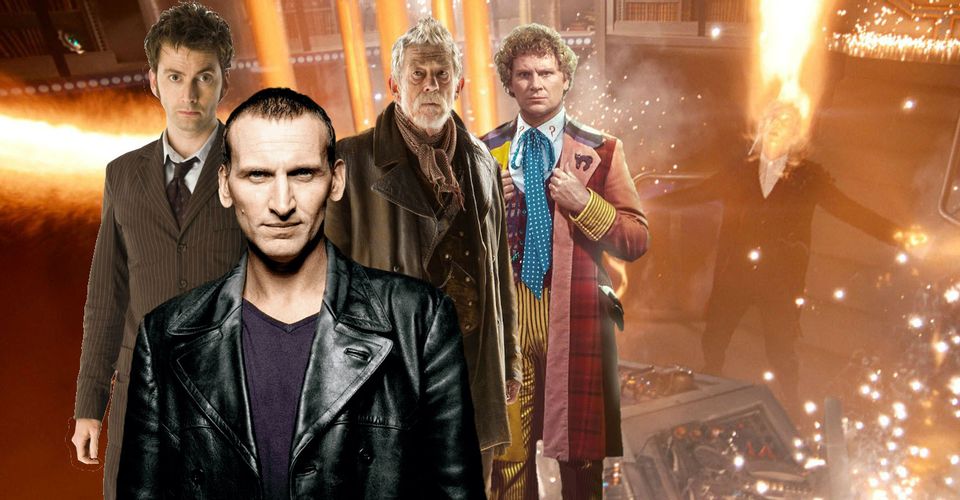Doctor Who: Why Each Doctor Regenerated

Here are all the monsters, injuries and mishaps that have caused the Doctor to regenerate in Doctor Who. Recasting a title character can be risky business for most TV and film franchises, but for Doctor Who, it’s an integral part of the mythology. In a unique trick, Time Lords have the ability to cheat death, renewing every cell in their bodies when they are gravely sick or fatally wounded. From a real-world point of view, regeneration provides Doctor Who with a legitimate way of continuing the show when the lead actor has had enough or, in some cases, is given the boot.
The rules and lore surrounding regeneration have changed and evolved over the years, with the term itself not introduced until the era of the Third Doctor. A Time Lord can regenerate a total of twelve times, but can also be afforded a brand new regeneration cycle by the Time Lord council – a gift bestowed upon the Doctor in Matt Smith’s final episode. More recent additions to the regeneration concept have shown that the process can alter gender and skin color, and Time Lords also have the option to refuse regeneration, should they wish.
Regeneration is one of Doctor Who‘s most innovative and useful concepts, but the process has been wildly different on almost every occasion. The Doctor’s regenerations have also been caused by a wide variety of different threats, some considerably more dramatic than others.
First Doctor

Doctor Who‘s early creative team cooked up the idea of regeneration after William Hartnell, the original actor to bring the Doctor to life, began to struggle with memorizing scripts and delivering lines. Seeking to continue the show with a younger star, the Doctor would “renew” himself and transform into a completely different man. Throughout the First Doctor’s final adventure, “The Tenth Planet,” the Time Lord appears weakened and frail, sometimes being forced to rest as he battles the Cybermen for the first time.
After helping save Earth from the deadly emergence of the Cybermen’s home planet, the Doctor wearily returns to his TARDIS and collapses, regenerating into his Second form. Although not explicitly addressed, the generally accepted reason for the First Doctor’s regeneration is old age. The Doctor is already several hundred years old before the start of Doctor Who and his recent adventures have evidently taken a toll on his ailing body.
Second Doctor

When it came time for Patrick Troughton to move on from Doctor Who, the “old age” excuse wasn’t going to work, with the Second Doctor not only younger and more cheerful than his predecessor, but far more sprightly. Instead, Doctor Who introduced another element to the mythology that would form a core part of the franchise for decades to come: the Time Lords.
Although clearly of alien origin, the Doctor’s background had never been previously addressed, but “The War Games” revealed his heritage and established the Time Lord code of non-interference. The Doctor was wildly in violation of said code, but a dire situation forced him to call for aid from his Gallifreyan kin, even knowing that punishment inevitably awaited. Charged with various counts of meddling, the Doctor was forced to give up his current regeneration and was exiled to Earth. Most heartbreakingly of all, the Second Doctor’s companions were forced to completely forget their adventures in the TARDIS.
Third Doctor

Jon Pertwee’s Third Doctor was the most human version yet, driving a jaunty car, joining U.N.I.T. and taking down baddies with his Venusian aikido. However, the Third Doctor’s eventual regeneration was definitively alien in nature. Having previously stolen a blue crystal from the planet Metebelis 3 for study, the Doctor discovers that a race of mutated giant spiders have taken over and are seeking the return of their crystal. While this sounds like a reasonable request, the spiders seek to use the crystal as part of a larger plan to dominate the galaxy.
Always a step ahead, the Doctor knows that the crystal’s overwhelming power will kill, not enhance, the spiders’ leader, and handing back the stolen crystal will therefore save the day. Problematically, the spider’s cave is teeming with lethal radiation but, in a noble effort to protect the universe, the Doctor ventures into the cave of the Eight Legs and hands over the crystal, defeating the spiders. Upon exiting, Pertwee’s Doctor barely has enough strength to pilot the TARDIS back to Earth and regenerate.
Fourth Doctor

Tom Baker’s regeneration into Peter Davison is unique in that it requires the cooperation of a mysterious third party. In “Logopolis,” the fabric of reality is beginning to unravel and the Doctor is forced to team up with the Master to save the universe. Although the unlikely duo succeed, the always-opportunistic Master threatens to restart the collapse unless control of the universe is handed over to him. Ascending a high radio tower, the Doctor manages to disconnect the dish broadcasting the Master’s ultimatum. With the Master tilting the tower’s gantry, however, the Doctor falls to the ground below, triggering his next regeneration.
Having been followed by a strange white figure known as “the Watcher” for the entire story, the dying Fourth Doctor reveals his stalker to be his own future incarnation, and the two Time Lords merge together during the regeneration process. Why the Watcher is a necessary component of this particular regeneration isn’t clear, but wider Doctor Who media suggests that seeing a Watcher is an occasional phenomenon that befalls Time Lords who are nearing a regeneration.
Fifth Doctor

In his final story, Peter Davison’s Fifth Doctor stumbles across a battle between various political and military factions for a valuable natural mining resource called Spectrox on the planet Androzani. While inspecting the Caves of Androzani, the Doctor’s assistant, Peri Brown, becomes entangled in an unknown sticky substance that is later revealed to be unrefined Spectrox. Both Peri and the Doctor make skin contact with the Spectrox and soon begin to exhibit symptoms of poisoning. The Fifth Doctor embarks on a mission deep into the caves to find the only known antidote to their condition and although he succeeds, he can only retrieve a single dose, curing Peri at his own expense.
Sixth Doctor

Colin Baker’s departure from Doctor Who and the BBC was an acrimonious one, and this resulted in the most abrupt regeneration sequence ever seen on the series. At the very beginning of the season 24 premiere, “Time And The Rani,” the TARDIS comes under attack from the planet Lakertya at the Rani’s command. After a barrage of energy blasts, the TARDIS is caught and boarded, where the Rani witnesses the Sixth Doctor regenerate into the Seventh.
The exact cause of Colin Baker’s regeneration isn’t made clear, and fans can only assume that he sustained severe injuries following the assault upon his ship, although subsequent audiobooks have sought to fill in the gaps of the Sixth Doctor’s demise.
Seventh Doctor

The classic series of Doctor Who was cancelled while Sylvester McCoy’s Seventh Doctor still held the keys to the TARDIS, but his story continued in the 1996 TV movie, which offered a regeneration sequence grounded in stark realism. Thanks to the Master, the Doctor’s TARDIS unintentionally materializes in 1999 San Francisco, right in the center of a shootout between two rival gangs. The Doctor’s sudden appearance spares the life of a young man named Chang Lee, but the Time Lord himself takes a barrage of bullets.
With dual hearts and Gallifreyan physiology, the Doctor actually survives the shooting, but is killed by well-meaning surgeons as they attempt to open the Doctor up and save his life. Aimlessly fiddling in a Time Lord’s body, Dr. Grace Holloway kills the recovering Doctor and he later regenerates in the building’s morgue.
Eighth Doctor

With his only appearance coming in the ill-fated movie, fans were left guessing as to how Paul McGann’s Eighth Doctor regenerated. Answers finally arrived in time for Doctor Who‘s fiftieth anniversary in the short film, “The Night of the Doctor.” Written by Steven Moffat, “The Night of the Doctor” sees the Time Lord desperately trying to avoid partaking in the burgeoning Time War spreading across the universe.
Travelling alone, the Doctor comes across Cass, the pilot of a doomed ship, and attempts to save her life. Unusually for Doctor Who, Cass refuses, not wanting to be saved by one of the Time Lords currently destroying galaxies with their endless war against the Daleks. For his part, the Doctor refuses to leave and with both passengers remaining stubborn until the end, the ship crashes, killing both. Fortunately, the Doctor seems to have landed on Karn, a former colony of Gallifrey introduced in the Fourth Doctor’s era. The planet’s natives, known as the Sisterhood, give the Eighth Doctor an elixir that will supposedly allow him to fully control the characteristics of his next regeneration.
War Doctor

Appearing in the 50th anniversary special, John Hurt’s War Doctor was a fleeting but welcome addition to Doctor Who canon and was seen regenerating at the end of “The Day of the Doctor.” Making reference to his body “wearing a bit thin,” the War Doctor’s regeneration can be attributed to old age, for the first time since 1966. However, it could also be argued that the War Doctor’s function was merely as a soldier in the Time War, and once that conflict was over, so was the War Doctor himself.
Ninth Doctor

For the second time, the Doctor sacrifices himself to save an assistant. Under assault from the Daleks, the Ninth Doctor sends his assistant, Billie Piper’s Rose Tyler, away in the TARDIS for her own safety. Rose refuses to accept being unable to help the Doctor and strives to find a way back to him, eventually absorbing the heart of the TARDIS and gaining God-like abilities. Rose saves the day but is rapidly becoming unstable, forcing the Doctor to absorb the power himself via a painfully cheesy kiss.
After restoring the TARDIS energy back to its original location, the Doctor begins to feel the effects of saving Rose, later claiming that no Time Lord is supposed to take in that much power. He promptly regenerates into David Tennant.
Tenth Doctor

David Tennant’s demise was a long time coming in Doctor Who, with the “he will knock four times” warning coming well in advance of the Tenth Doctor’s final episode. Viewers were misled into believing this prophecy would be fulfilled by the Master or Rassilon but, in the end, it was Bernard Cribbins’ Wilf that heralded the end of the Tenth Doctor’s reign.
During the dramatic final confrontation of “The End of Time,” Wilf selflessly frees an innocent worker from a two-man radioactive chamber, locking himself in until another person can take his place. When the dust settles, the Doctor hears the gentle knocking and realizes he must sacrifice his own life to save Wilf, absorbing a deadly dose of radiation in the old man’s stead. After a whirlwind tour of his old friends, the Tenth Doctor delivers an emotionally devastating final line and regenerates in explosive fashion.
Eleventh Doctor

For the third time in his life, the Doctor died of old age when his Eleventh incarnation resolved to protect the planet of Trenzalore for hundreds of years, guarding a crack that separated the hidden planet Gallifrey from the amassing Dalek fleet waiting to resume the Time War. And since the Tenth Doctor had avoided a regeneration through the use of a preserved severed hand, Smith’s Doctor was already out of lives.
After deterring the potential conflict for the remaining years of his Eleventh iteration, the Doctor consigned himself to a death of the permanent kind, but was spared this fate by the Time Lords, who granted him a brand new regeneration cycle.
Twelfth Doctor

Peter Capaldi’s regeneration was special in the sense that it was triggered by damage accumulated throughout the Twelfth Doctor’s final adventure. Coming up against a powerful army of Cybermen and two incarnations of the Master, the Doctor’s first major injury arrives in the form of Cyberman electrocution. Although the Doctor survives, he spends several weeks recovering from the attack and is unable to heal a cut on his forehead, with golden regeneration energy beginning to brew from his hands.
Delaying his forthcoming renewal, the Doctor later engages multiple Cybermen in combat and endures several energy blasts before detonating an explosion that not only wipes out his mechanical enemies, but puts paid to any chance the Doctor had of recovering from his previous wounds. Capaldi’s regeneration marks a rare occasion in Doctor Who history that a major villain has succeeded in directly killing the Doctor.
Doctor Who season 12 premieres in 2020 on BBC and BBC America.
About The Author


















